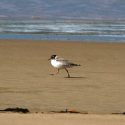The endangered hooded plover thrives on beaches such as Ocean Grove, but many chicks do not survive.
Disturbance by people, dogs and horses, as well as predation by silver gulls, ravens and foxes means that the hooded plover is up against the fight for survival even before they hatch.
Each year Ocean Grove has several hooded plover families that attempt to breed, only to have the chicks killed before they can fly, which is usually around five weeks after they hatch.
They are vulnerable because they nest at ground level, often above the high-tide mark on ocean beaches or among dunes.
In the meantime, they are extremely vulnerable.
One family of hooded plovers had a chick that, at the time of writing, was close to being able to fly.
The chick was given the best chance of survival thanks to a caring local community.
Exclusion zones around the hooded plovers’ nest has been successful and many hours of volunteering by locals ensured the chick was close to surviving.
“The hooded plover roped-off area was a bigger zone than usual, as the hooded plover family were very mobile,” Voice Nature Watch columnist Jen Carr said.
Hooded Plovers are a rarity along the Great Ocean Road and so the Bellarine Peninsula is the last major population of the birds until Warrnambool, making it a high priority at a national scale.
Although there are around 2000 hooded plovers in Western Australia, there are only 50 left in New South Wales, 400 to 450 in Victoria, 600 to 800 in South Australia and about 1000 in Tasmania.
Fighting for survival

Digital Editions

-

Rug up for Nature Festival
Geelong’s Nature Festival is returning with a vibrant family fun day at the historic Fyansford Paper Mill. The event is a free, family-friendly winter adventure…






